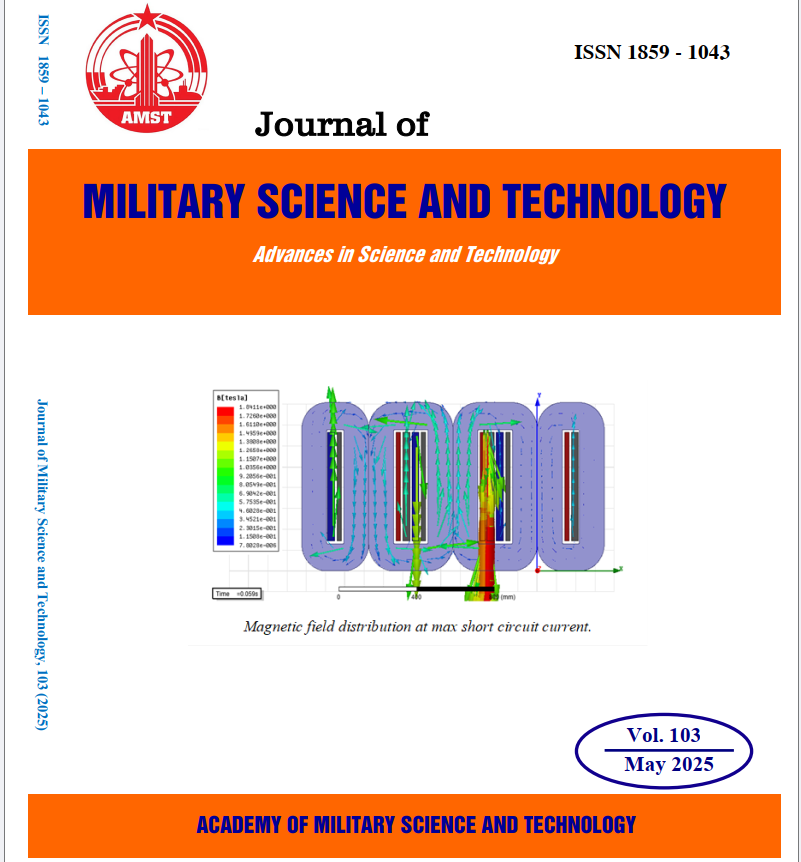Laboratory assessment of thermal transmission in camouflage materials using the SR-5000N spectroradiometer
370 viewsDOI:
https://doi.org/10.54939/1859-1043.j.mst.103.2025.74-81Keywords:
Thermal camouflage, Thermal signature, Emissivity, Thermal transmission, SR-5000N spectroradiometerAbstract
Recent domestic research on camouflage requires standardized evaluation methods and techniques to scientifically and reliably assess camouflage materials, such as fabrics and camouflage nets. This poses significant challenges due to the high level of confidentiality in the field and the limitations of experimental equipment. Drawing on several standards published by advanced nations, this study proposes a method for determining the thermal radiation transmission ratio through camouflage materials in a laboratory setting using the SR-5000N device. The proposed method offers several advantages, including rapid execution, accuracy, reliability, and broad spectral coverage, encompassing the two primary spectral regions of thermal camouflage: the mid-wave infrared (MWIR) and the long-wave infrared (LWIR) ranges. Independent field evaluations have validated the method’s effectiveness, demonstrating its practicality in saving time and resources for assessing the performance of thermal camouflage.
References
[1]. N.T. Cầm, “Nguỵ trang nghi trang trong phòng chống trinh sát quang điện tử,” Giáo trình đào tạo NCS của Viện KH-CN quân sự/BTTM, NXB Quân đội Nhân dân (2023) (in Vietnamese).
[2]. N.N. Son et al., “Advances in manufacturing multi-layer materials for thermal camouflage applications,” Journal of Military Science and Technology, 97, 3-15, (2024).
[3]. N.N. Son et al., “Developing computational and experimental models of heat transfer through multi-layered textile structures”, Comm. Phys., vol. 34, no. 4, (2024). DOI: https://doi.org/10.15625/0868-3166/20945
[4]. A. Roglski, “Infrared detectors, An overview,” Inf. Phys. Technol. 43, tr. 187-210, (2002). DOI: https://doi.org/10.1016/S1350-4495(02)00140-8
[5]. D. Peric et al, “Thermal imager range: Predictions, expectations and reality,” Sensor, 19(15), 3313, (2019). DOI: https://doi.org/10.3390/s19153313
[6]. J. Berela, M. Kastek, “Measurement and analysis of the parameters of modern long-range thermal imaging cameras”, Sensor (17), 5700, (2021). DOI: https://doi.org/10.3390/s21175700
[7]. F.B. Olsen, “Methods for evaluating thermal camouflage,” A FFI Report No. RTO-MPSCI-145, (2005).
[8]. C. Plesa et al, “The use of infrared radiation for thermal signatures determination of ground targets,” Rom. J. Phys. 51, pp.63–72, (2006).
[9]. J.G. Hixon et al, “Target detection cycle criteria when using the target task metric,” SPIE 5612, pp. 275–276, (2004). DOI: https://doi.org/10.1117/12.577830
[10]. G.C. Holst, “Common sense approach to thermal imaging,” JCD and SPIE Pub., 2000, pp. 265–290. DOI: https://doi.org/10.1117/3.2588945
[11]. O. Dev et al, “Multi-layered textile structure for thermal signature suppression of ground-based targets,” Inf. Phys. Technol. 105, 103175, (2020). DOI: https://doi.org/10.1016/j.infrared.2019.103175
[12]. Hexels, “Thermal Camouflage sheet,” US Patent 7244684 B2, (2007).
[13]. Hellwig et al, “Thermal Camouflage tarpaulin,” US Patent 7148161 B2, (2006).
[14]. Cox et al, “Infrared Camouflage covering,” US Patent 6127007, (2000).
[15]. G.D. Culler et al, “Infrared reflective coverings,” US Patent 5750242, (1998).
[16]. V. Rubeziene et al, “Reduction of thermal signature using fabrics with conductive additives,” Mater. Sci. (Medziagotyra) 19, pp.409–414, (2013). DOI: https://doi.org/10.5755/j01.ms.19.4.1730
[17]. C. Oahman, “Emittance Measurement using AGEMA E-Box,” Technical Report, AGEMA, (1999).
[18]. Z.S. Abdel-Rehim et al, “Textile fabrics as thermal insulators,” AUTEX Res. J.6, pp.148-161, (2006). DOI: https://doi.org/10.1515/aut-2006-060305
[19]. M. Matusiak, “Investigation of the thermal insulation properties of multilayer textiles,” J. Fibres Text. East. Eur. 14, pp.98–102, (2006).
[20]. N.N. Son et al, “A high-accuracy measurement method of surface emissivity using a spectroradiometer SR-5000N,” Proc. of 8th CASEAN, 28-30 August, Vinh, pp.674-681, (2023).
[21]. M. Honner and P. Honnerová, “Survey of emissivity measurement by radiometric methods,” Appl. Opt. 54, 669-683, (2015). DOI: https://doi.org/10.1364/AO.54.000669
[22]. O. Nagahisa et al, “Infrared emissivity measurement based on polarized reflection characteristics of non-transmissive insulators,” Mechanical Engineering Journal, 24-00115, (2024). DOI: https://doi.org/10.1299/mej.24-00115
[23]. G. Gillberg, A. Grop and M. Nysten, Technical specification MLCN, FMV, pp. 8-9, (2013).
[24]. N. Li et al, “Research status and development trend of image camouflage effect evaluation,” Multimedia Tools and Applications, 81, pp. 29939-29953, (2022). DOI: https://doi.org/10.1007/s11042-022-12287-3
[25]. R. Karli et al, “A multispectral Camouflage net evaluation capability,” IEEE Access, 12, 143378-143391, (2024). DOI: https://doi.org/10.1109/ACCESS.2024.3471182
[26]. N.N. Son et al, “Research on evaluating camouflage effectiveness based on the data envelopment analysis (DEA) model,” Proc. of ICPA-13, 14-17 October, Ha Noi (2024).







